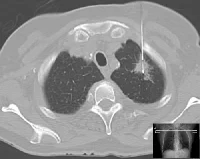A decrease in smoking rates may mean that many people who could have benefited from early detection of lung cancer are dying because they do not qualify for low-dose CT scans, according to a Mayo Clinic-led study reported in JAMA. Lung cancer screening using low-dose computed tomography is recommended for high-risk individuals by professional associations, including the U.S. Preventive Services Task Force (USPSTF).
“As smokers quit earlier and stay off cigarettes longer, fewer are eligible for CT screening, which has been proven effective in saving lives,” said Ping Yang, MD, PhD, an epidemiologist at Mayo Clinic Cancer Center. “Patients who do eventually develop lung cancer are diagnosed at a later stage when treatment can no longer result in a cure.” Researchers and policymakers need to re-examine screening criteria to identify a greater proportion of patients who develop lung cancer, she pointed out.
Dr. Yang and colleagues conducted a study to examine the trends in the proportion of patients with lung cancer meeting the USPSTF screening criteria. Those criteria, used by doctors and insurance companies, recommend CT screening for asymptomatic adults age 55 to 80 who have smoked at least 30 pack-years (one pack a day for 30 years), and are still smoking or have reduced consumption in the last 15 years.
The study retrospectively tracked residents of Olmsted County in Minnesota who were older than 20 years from 1984 through 2011 — approximately 140,000 people. Lung cancer cases were identified using the Rochester Epidemiology Project database and confirmed by pathology definition of the World Health Organization.
A total of 1,351 people in the study developed primary lung cancer between 1984 and 2011. The research team found that the incidence of primary lung cancer fell overall during the study period — but only for men by about one-third. Among women, the incidence of lung cancer increased by eight percent.
As Dr. Yang noted, the data with greatest relevance to CT screening is the proportion of lung cancer patients who smoked at least 30 pack-years which declined over the study period. Moreover, the proportion of cancer patients who had quit for more than 15 years increased. “While more people have quit for a longer period of time, they are still getting lung cancer,” Dr. Yang said, “and they make up a larger proportion of newly diagnosed lung cancer patients.”
The team found there was a decline in the relative proportion of patients with lung cancer meeting the USPSTF criteria overall, from 57 percent in 1984-1990 to 43 percent in 2005-2011. The proportion of patients who would have been eligible under the criteria decreased among women from 52 percent to 37 percent, and from 60 percent to 50 percent among men.
"The decline in the proportion of patients meeting USPSTF high-risk criteria indicates that an increasing number of patients with lung cancer would not have been candidates for screening. More sensitive screening criteria may need to be identified while balancing the potential harm from computed tomography," according to the research team.
Dr. Yang would like to see screening criteria adjusted to include smokers who have smoked less than 30 pack-years and those who quit more than 15 years ago. “We don’t want to penalise people who succeeded in smoking cessation,” she said, adding that she is aware of many smokers who are cancer-free but continue to smoke in order to be eligible for CT screening.
Dr. Yang said she and her colleagues "are preparing papers on these issues" to develop proposals for more effective CT screening that will save more lives from lung cancer.
Source: Mayo Clinic
Image Credit: Pixabay
“As smokers quit earlier and stay off cigarettes longer, fewer are eligible for CT screening, which has been proven effective in saving lives,” said Ping Yang, MD, PhD, an epidemiologist at Mayo Clinic Cancer Center. “Patients who do eventually develop lung cancer are diagnosed at a later stage when treatment can no longer result in a cure.” Researchers and policymakers need to re-examine screening criteria to identify a greater proportion of patients who develop lung cancer, she pointed out.
Dr. Yang and colleagues conducted a study to examine the trends in the proportion of patients with lung cancer meeting the USPSTF screening criteria. Those criteria, used by doctors and insurance companies, recommend CT screening for asymptomatic adults age 55 to 80 who have smoked at least 30 pack-years (one pack a day for 30 years), and are still smoking or have reduced consumption in the last 15 years.
The study retrospectively tracked residents of Olmsted County in Minnesota who were older than 20 years from 1984 through 2011 — approximately 140,000 people. Lung cancer cases were identified using the Rochester Epidemiology Project database and confirmed by pathology definition of the World Health Organization.
A total of 1,351 people in the study developed primary lung cancer between 1984 and 2011. The research team found that the incidence of primary lung cancer fell overall during the study period — but only for men by about one-third. Among women, the incidence of lung cancer increased by eight percent.
As Dr. Yang noted, the data with greatest relevance to CT screening is the proportion of lung cancer patients who smoked at least 30 pack-years which declined over the study period. Moreover, the proportion of cancer patients who had quit for more than 15 years increased. “While more people have quit for a longer period of time, they are still getting lung cancer,” Dr. Yang said, “and they make up a larger proportion of newly diagnosed lung cancer patients.”
The team found there was a decline in the relative proportion of patients with lung cancer meeting the USPSTF criteria overall, from 57 percent in 1984-1990 to 43 percent in 2005-2011. The proportion of patients who would have been eligible under the criteria decreased among women from 52 percent to 37 percent, and from 60 percent to 50 percent among men.
"The decline in the proportion of patients meeting USPSTF high-risk criteria indicates that an increasing number of patients with lung cancer would not have been candidates for screening. More sensitive screening criteria may need to be identified while balancing the potential harm from computed tomography," according to the research team.
Dr. Yang would like to see screening criteria adjusted to include smokers who have smoked less than 30 pack-years and those who quit more than 15 years ago. “We don’t want to penalise people who succeeded in smoking cessation,” she said, adding that she is aware of many smokers who are cancer-free but continue to smoke in order to be eligible for CT screening.
Dr. Yang said she and her colleagues "are preparing papers on these issues" to develop proposals for more effective CT screening that will save more lives from lung cancer.
Source: Mayo Clinic
Image Credit: Pixabay
References:
Wang Y, Midthun DE, Wampfler JA (2015) Trends in the proportion of patients with lung cancer meeting screening criteria. JAMA, 313(8): 853-5. doi:10.1001/jama.2015.413.
Latest Articles
lung cancer, CT scans, computed tomography, JAMA, smoking, Mayo Clinic
A decrease in smoking rates may mean that many people who could have benefited from early detection of lung cancer are dying because they do not qualify fo...










